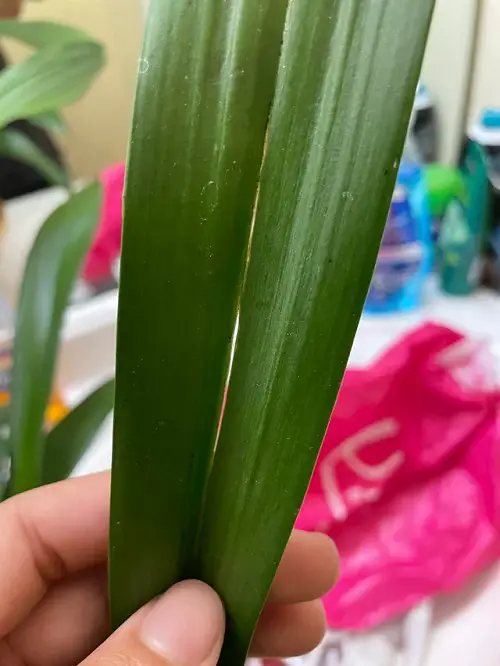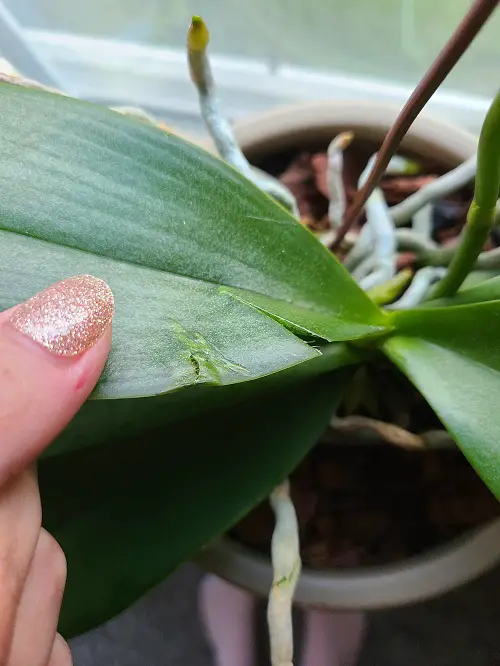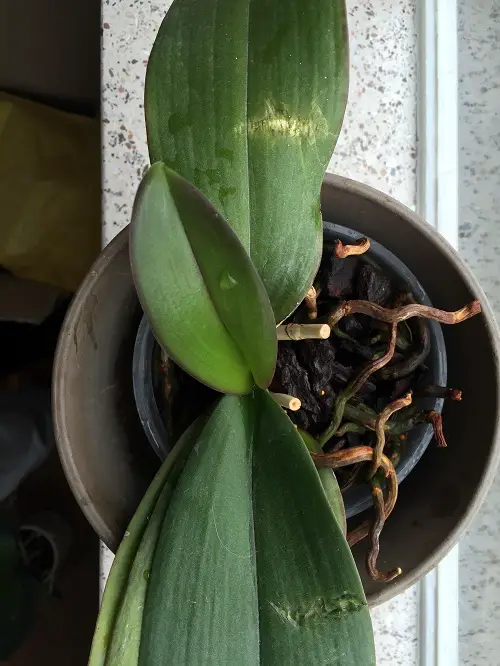Are you worried about Orchid Leaves Splitting? We are here to help you out with all the possible reasons and their solutions!

You are taking care of your orchids well, but suddenly, you see craked leaves, and you must be thinking, why are my orchid leaves splitting? Well, there can be many reasons behind this, and we will discuss them in detail with their solutions.
Why Do Orchid Leaves Split – Main Reasons
Orchids are sensitive plants that prefer stable conditions, and if they’re exposed to sudden, extreme environmental changes, their leaves might crack or split in response. For instance:
Temperature Fluctuations
Depending on the species, orchids are classified under three categories based on their temperature needs:
- Warm orchids from sea-level rainforests need 80-90°F in days and 65-70°F at nights.
- Intermediate orchids are native to subtropical climates and require 70-80°F days and 55-65°F night temperature.
- Cool orchids originate in high-altitude cloud forests and thrive in 60-70°F days and 50-55°F nights.
If the temperature suddenly drops below or rises above their respective ranges, the orchids could respond by developing split leaves.
Humidity levels
Most orchids prefer humidity levels between 40% and 70%. In a low-humidity environment, species like moth orchid leaves can dry out and potentially split.
Lighting changes
While orchids need light to photosynthesize and grow, abrupt changes in light levels can also lead to leaf splitting. This is especially true if the orchid is suddenly exposed to direct, intense sunlight after being in a more shaded environment.
What Causes Orchid Leaves to Split – Reasons and Solutions
1. Under or Overwatering
Orchid leaves need a good balance of water. If you forget to water, the leaves will become dehydrated, show wrinkles, and split. If you give the leaves excess water, they will swell up and try to return to normal shape—this tension will weaken the parts of the leaf and result in splitting.
Solution: Your watering schedule should be adjusted depending on the variety of orchid and its environment. A general rule is to water just as the orchid’s medium is drying out. Make sure the water can drain freely to avoid waterlogging.
2. Excessive Sunlight and Heat Intensity

Excessive exposure to sunlight is the primary reason why the orchid leaves show cracks.
Solution: Many orchid varieties thrive well in indirect sunlight, so place your plant in a spot where it receives plenty of indirect sunlight – a north or east-facing window will probably be a good choice!
Note: Avoid keeping the Phalaenopsis orchid (common variety) in a facing window during the summer.
3. Low Humidity
When the air is too dry, orchids can struggle to take up enough moisture through their roots and leaves, leading to dehydration. The lack of water can cause the plant cells in the leaves to shrink and collapse, resulting in visible physical damage like leaves splitting, wrinkling, or shriveling of the foliage.
Additionally, low humidity levels can exacerbate the effects of other stressors like high temperatures and strong light, leading to faster water evaporation from the plant tissues and potentially causing the leaves to split.
Solution: To increase humidity for indoor orchids, you can use a humidifier or place the orchid on a tray filled with water and pebbles. The water should not touch the bottom of the orchid pot, as the intention is to increase the humidity around the plant, not to water it. As the water evaporates from the tray, it will create a more humid environment around the orchid.
Check out the Ways To Increase Humidity For Houseplants
Note: Humid conditions can encourage the growth of fungal and bacterial diseases as well, so make sure your orchid has good airflow.
4. Bacterial Infections

The two main types of infections that can cause leaf splitting are due to these bacteria:
- Bacterial soft rot in orchids, primarily affecting Phalaenopsis and Dendrobium species, is caused by the bacterium Erwinia chrysanthemi. This pathogen thrives in wet conditions, leading to rapid deterioration and death of the plants, especially in seedlings and young plants.
- Black rot in orchids, caused by the fungi Pythium ultimum and Phytophthora cactorum, thrives in moist conditions and can be devastating.
Solution: To manage soft rot, ensure good air circulation, practice stringent hygiene, manage watering to keep foliage dry, and consider using appropriate bactericides to control the spread of the disease.
To prevent and manage black rot, it’s crucial to maintain dry conditions, ensure good air circulation, and elevate plants to prevent soil splash. Orchids should be isolated at the first sign of infection, and tools and pots must be sterilized to avoid spreading the fungi. Additionally, using high-calcium fertilizers can strengthen plants against future infections.
Check out the Best Homemade DIY Fungicide Recipes
Quick Tips on Preventing Orchid Leaves Splitting
- Position your orchids where they are out of reach from children and pets. Educate your children on the importance of not handling the flowers to maintain their health and beauty.
- Regularly water your orchids, ensuring they are hydrated but not waterlogged. If the leaves look dry, consider giving them a little more water.
- Place your orchids in a spot with good lighting and humidity to prevent leaf damage.
- Handle your orchids gently. Avoid shaking or rough handling. When moving them, lift and carry them carefully, without rushing.
- Feed your orchids with the right fertilizers to ensure they receive the essential nutrients for strong and healthy growth.




